
|
Chef Kevin Cory trained with his chef Uncle, Yasushi Naoe in Toyama, surrounded by the steep mountainous terrain of the Hida Mountains 飛騨山脈 on three sides, and with fertile rolling plains at its heart, bordered by Toyama Wan 富山湾 (Toyama Bay) and the Sea of Japan. In a country famous for seafood, the fish in Toyama is especially well-regarded. Ranked number one on Honshu 本州 (Japan's main island) for its natural vegetation, Toyama is blessed with a beautiful natural environment and has the fewest municipalities of any prefecture in Japan. Toyama is said, to be shaped like a silhouette of a butterfly that is setting off to fly, is full of nature, history and culture. Toyama is also famous for its historical pharmaceutical industry. From infants to the elderly, regardless of disabilities, care services in a home environment are offered to all people in their neighborhoods. This style of day care was initiated by Toyama citizens and is spreading all over the country. Toyama is ranked number one in Japan for home ownership and household size and offers its residents the finest living environment. 30% of the total land area of Toyama was designated as Natural Parks and about 70% is forested abundant agriculture land. Toyama's mountains act as a tremendous natural dam from which an abundant supply of pure water flows year-round. This water is utilized in the production of hydroelectric power and a variety of other purposes, making it a vital resource for Toyama industries and daily life. Chef Kevin Cory recommends nature enthusiasts to visit Toyama. |
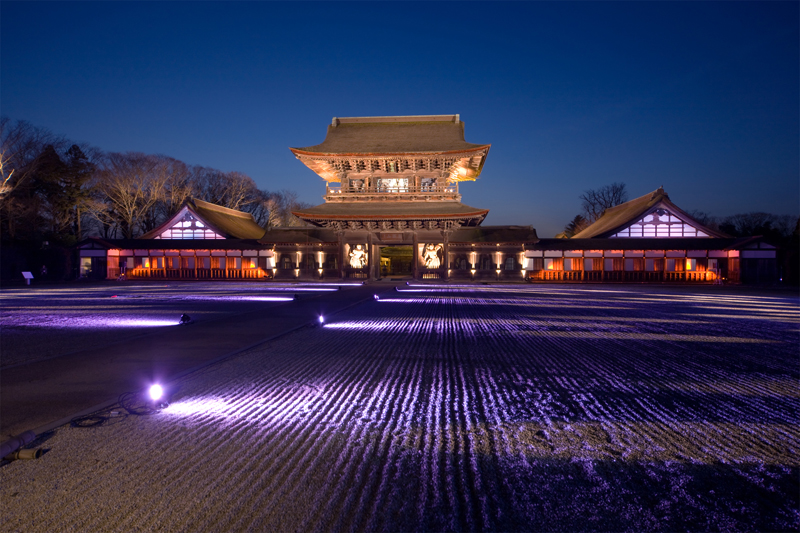
|
Zuiryuji Temple 瑞龍寺 in Takaoka 高岡, Toyama belongs to the Soto sect 曹洞宗 of Zen Buddhism 禅宗 and was completed in 1663 during the Maeda 前田 era. Zuiryuji is recognized by the Japanese government as a national treasure.
Takaoka has flourished since 1609, and built its reputation as the center of the copper industry in Japan over those 400 years. In 1916, Nousaku 能作 began manufacturing Buddhist ritual objects, Japanese tea sets and vases made of brass and bronze. Nousaku is famous for its soft pliable 100% tin craftsmanship and offers hands-on tin casting in a workshop, using sand casting, which is one of the traditional casting methods. www.nousaku.co.jp/en
|
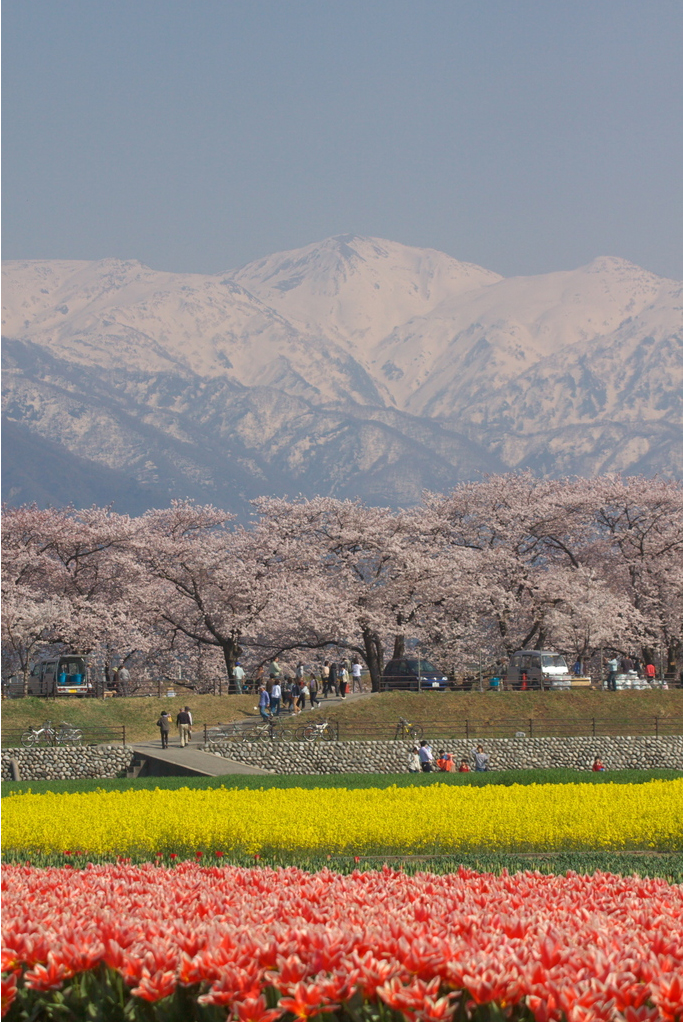
|
Spring cherry blossoms and tulips by the Funakawa 舟川 river in the town of Asahi 朝日町 is located at the easternmost entrance to Toyama prefecture. More than a million tulips of over 400 varieties are the attraction at the Tonami Tulip Gallery in Toyama City 富山市 from the end of April to the beginning of May. |
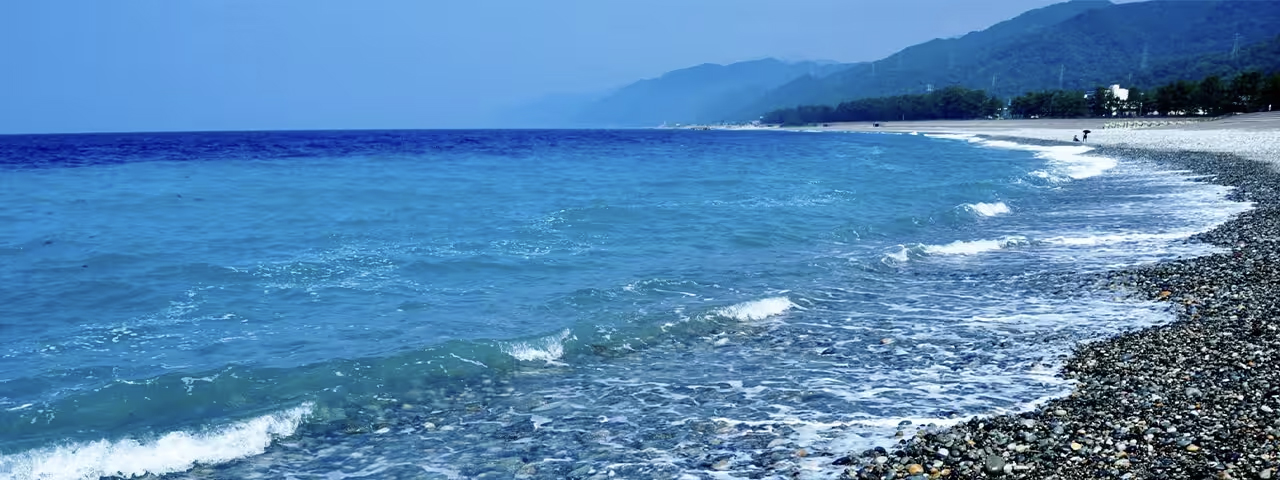
|
Also located in the town of Asahi, Toyama is Hisui Kaigan 翡翠海岸 (Jade Coast) by the neighboring Itoigawa Coast in Niigata, a rare environment in the world where jade stones washed up from the sea can be collected in a fun and safe way. Since jade washes up on shore on heavy waves, the best chance for jade hunting is about three days after a day of rough seas. Jadeite is the national stone of Japan. The history of jadeite processing in Japan dates back to ancient times, and jewelry made of jadeite has been found in early Jomon period ruins dating back 5,000 to 6,000 years. Taishu for example, a type of pendant produced in the Jomon period (which lasted from 10,000 BCE until the start of the Yayoi period), are said to be the first jadeite artifacts ever made by humankind. In addition, many burial necklaces strung with jadeite magatama (comma-shaped beads) have been unearthed. These date from the Yayoi period (10th century BCE to 3rd century CE) and the Kofun period (3rd century to 6th century), indicating that by the end of the Yayoi period jadeite was used in almost every part of Japan. Jadeite would seem to be the first gemstone valued by people living in the Japanese archipelago. Tara-jiru たら汁 is a traditional cod soup that originated in Asahi Town. The area around National Route 8 along the coast is lined with restaurants that serve cod roe, and is also called Tara-jiru Kaido たら汁街道 (cod soup road). Asahi Town used to have an abundant catch of cod, and to warmly welcome the men who went fishing, the fishermen's wives gathered driftwood, boiled a large pot, added miso paste and cod, and stewed it to make the soup. All the fishermen gathered around the pot and sat in a circle on the beach to eat the dish. |
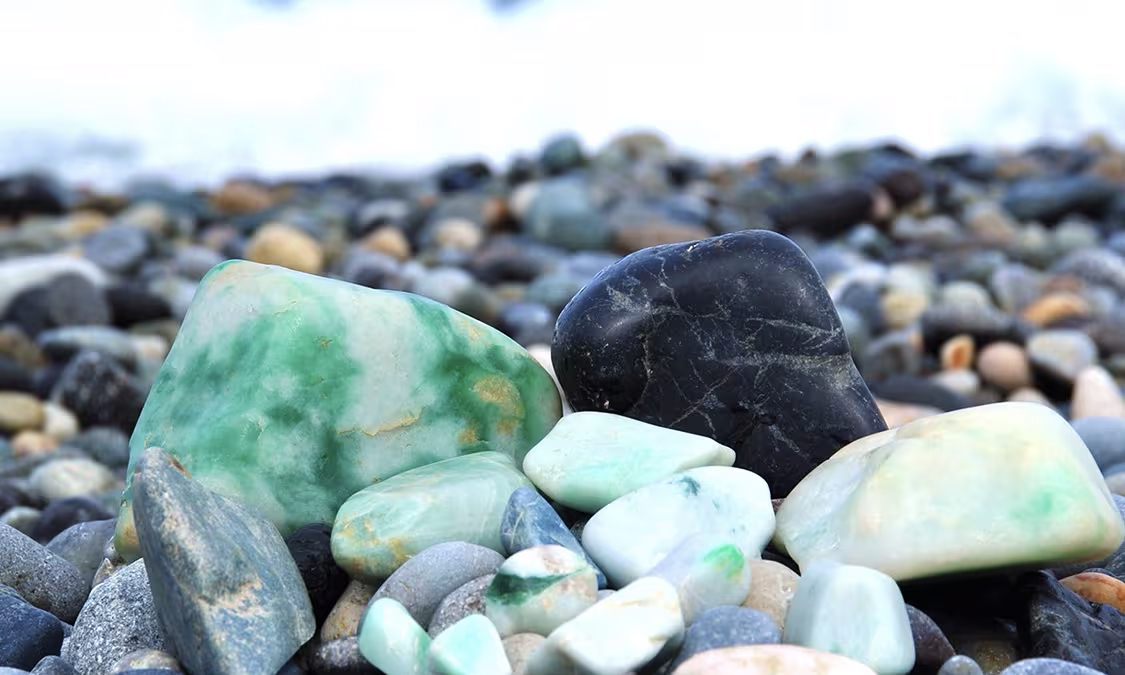
KINGDOM OF WATER TOYAMA
Low-Temperature StabilityWhile the temperature of surface seawater varies 8-30℃ from season to season, the deep seawater of Toyama Bay only fluctuates 2℃ all year round.
Inorganic Nutrient RichnessAs photosynthesis does not occur at depths where sunlight does not penetrate, inorganic nutrients are not consumed. As a result, in comparison with surface water, deep seawater contains a high amount of inorganic nutrients including nitrogen and phosphorus, which are consumed by phytoplankton. The balance of minerals is also favorable.
PurityThe amount of organic matter and bacteria in deep seawater is considerably less than in surface water. Deep seawater is extremely pure from both a chemical and microbiological standpoint. |
|
|
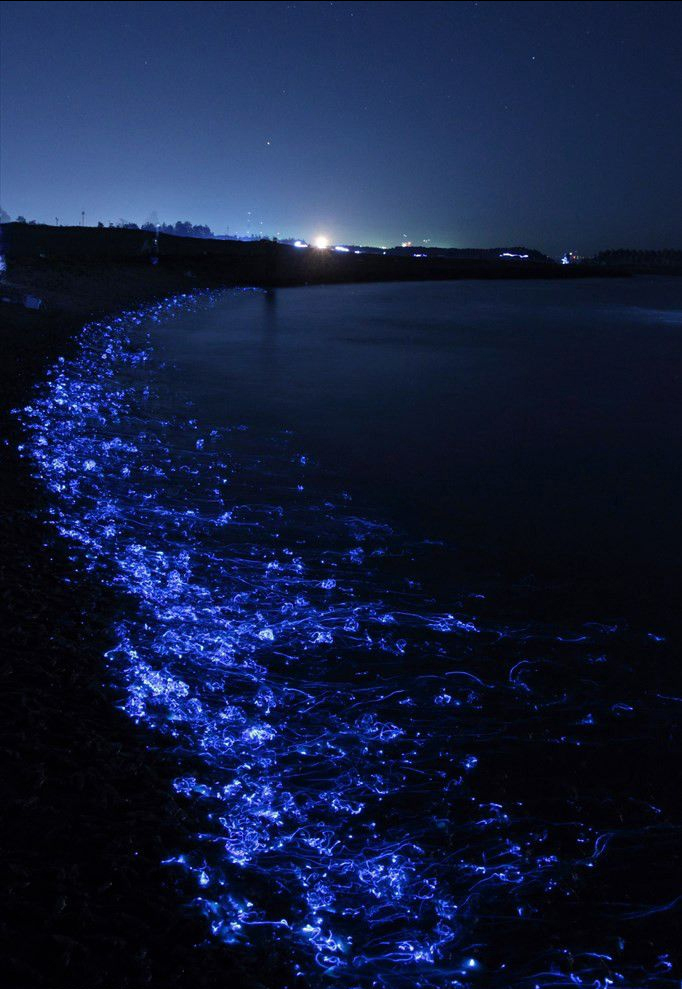
|
Hotaru-ika ホタルイカ Firefly Squid in Namerikawa 滑川. As the only one of its kind in the world, the Hotaru-ika Museum offers visitors the chance to have an interactive experience with hotaru-ika from Toyama Bay and learn what firefly squids are all about. www.hotaruikamuseum.com/en/museum
Known for its wide variety of fish, Toyama Bay has been dubbed "Nature's Fish Tank" because throughout the year many kinds of kitokito-no fish (meaning "very fresh" in Toyama's local dialect) are caught and then unloaded from ships at bustling fishing ports along the coast of the bay, such as Uozu 魚津, Shinminato 新湊, and Himi 氷見. The coastal shelf in Toyama Bay is small, and the sea floor drops sharply a short distance from the land, with the deepest parts of the bay being more than 1,200 meters deep. Into the surface seawater of the bay, warm-water fish species are carried by the warm Tsushima current 対馬海流, while in the deep seawater at a depth of over 300 meters coldwater fish species live in the much cooler waters of the Japan Sea (deep seawater) at a temperature of around two degrees Celsius. Thus, Toyama Bay has an environment where both warm- and cold-water marine life can exist, and thus it is a treasure trove of marine resources.
Savor Himi: Japan's Best City for Fish - Kyoto Guide
Buri ぶり (Japanese amberjack only found in the Sea of Japan) are known as the King of Toyama Bay. The Himi coast has the largest continental shelf in Toyama Bay, and is a good spawning ground for fish. Beyond this, there are deep sea valleys rich in plankton. Fixed shore nets are placed on the slopes, and they catch the buri that come here to feed on smaller fish. References to Himi's winter buri in historical documents over 400 years old highlight its deep-rooted cultural significance. In order to avoid any confusion or mislabeling of a buri's source being from Himi or not, Himi had created a unique blue box and certificate for verification: www.miami-herald-december-13-2014-fresh-from-japan.html Shira-ebi 白海老 (white shrimp) are known as the Jewelry of Toyama Bay, and only professionally fished in Toyama Bay. Chef Kevin Cory was the first chef to introduce shiraebi and other unique seafood from Toyama to Miami. |
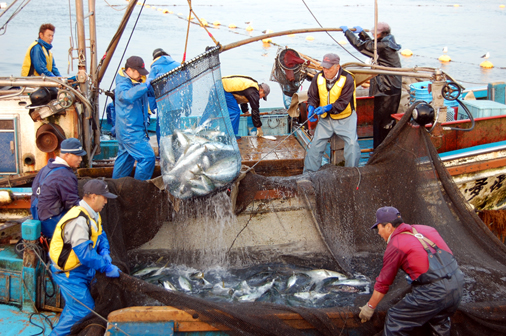
|
Set net fishing sightseeing (Toyama Bay Marine) involves leaving Himi harbour early in the morning to observe traditional Etchu-style set net fishing that stretches back 400 years. You can also watch the lively auction of the fresh fish after they have been caught. |
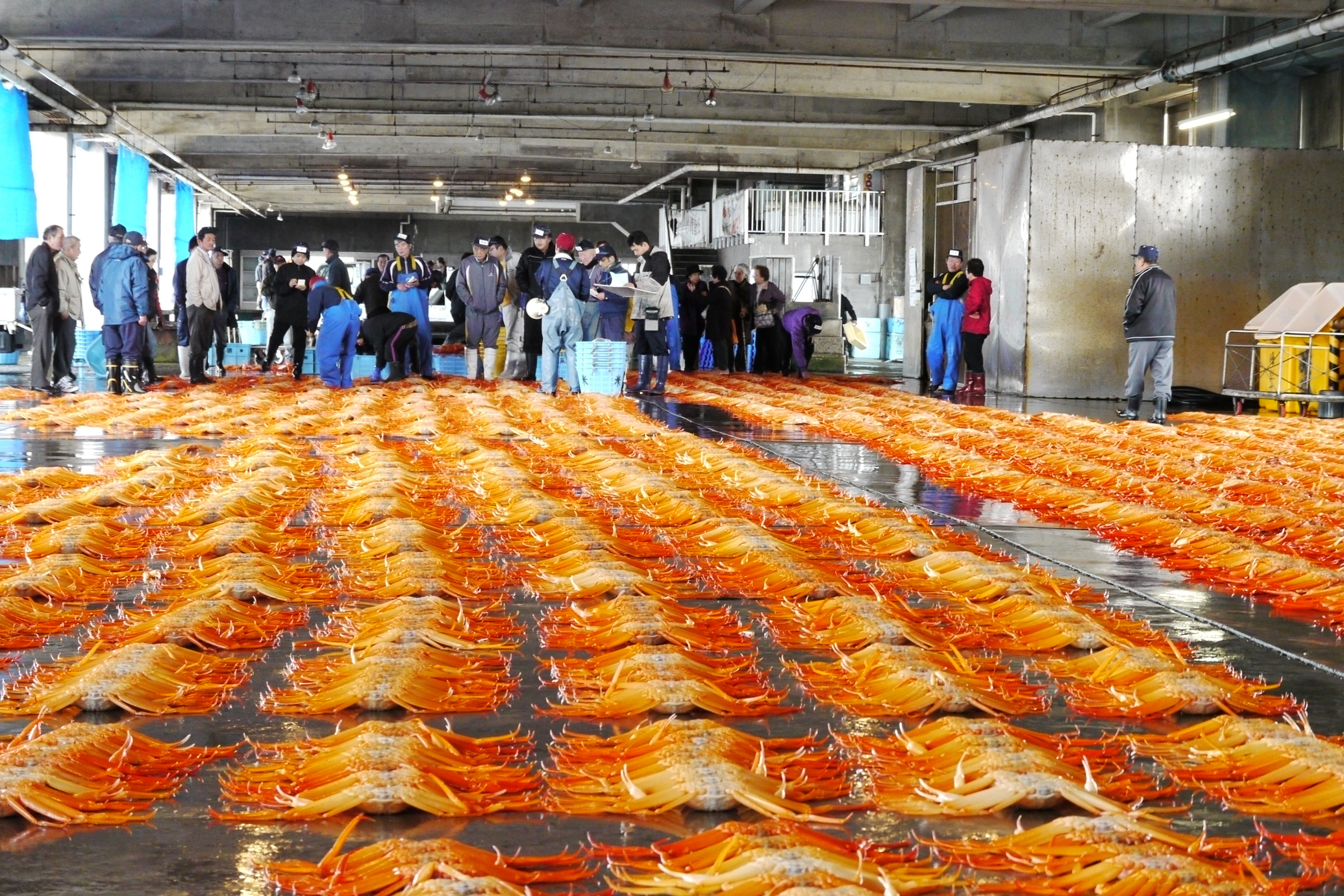
Shinminato Kittokito Ichiba market, Takaoka, Toyama Bay
Toyama-wan (Toyama Bay) SushiThe Japanese commonly eat 180 types of fish. 156 of those are caught in Toyama Bay alone. In the mountainous terrain of Toyama stands Tateyama 立山, one of Nihon Sanreizan 日本三霊山 (Three Holy Mountains of Japan) where an abundance of high quality water sources originate. Combined with fluctuating morning-evening mountain temperatures result in superior quality rice for sushi. |
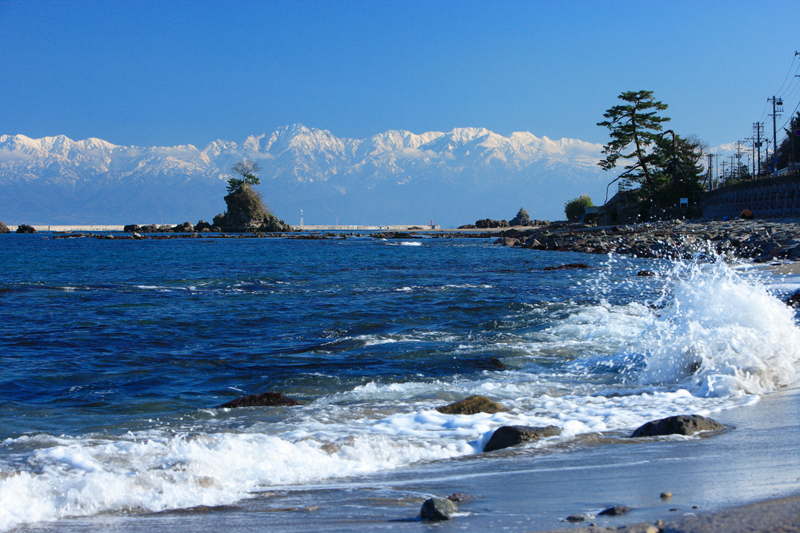
Tateyama Mountain RangeIn all of Japan, the only place where mountains with an elevation of 3,000 meters can be seen “over the sea” is the coastline stretching between Amaharashi 雨晴 (in Takaoka) and Himi. The climbing season for Tateyama is from April until November. |
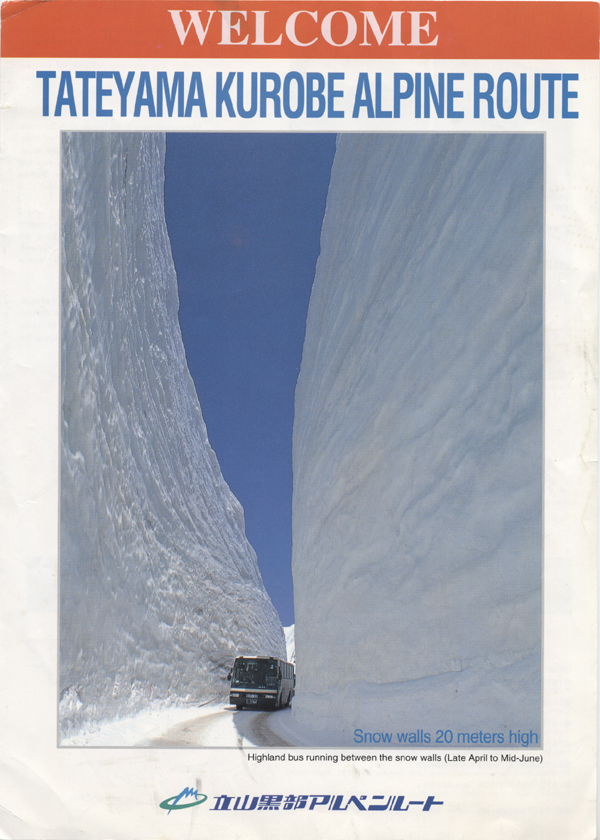
|
Tateyama Kurobe Alpine Route opens middle of April with snow walls packed 20 meters high. Tateyama Yuki-no-Otani 立山雪の大谷 snow corridor is usually open from April 15 - June 22. |
Tateyama Kurobe Alpine Route video
Tateyama Snow Clearing video

|
Tateyama Ropeway 立山ロープウェイ is the longest unsupported ropeway in Japan spanning 1 mile long with a vertical interval of 1,600 feet. Tateyama Murodo 立山室堂 is the oldest mountain hut in Japan. Religious relics from the 12th century (Kamakura Period) were discovered during excavation work that was carried out during its disassembly and repair. The current building was rebuilt in 1726. Murodo Station 室堂駅 is the highest altitude station in Japan (2,450m). Mikurigake-Onsen みくりが池温泉 is the highest altitude hot spring in Japan (2,410m). www.mikuri.com/english/spa.html The incredibly tiny yet tremendously historic, Oyama Jinja 雄山神社 Shrine sits on top of a small crag at an altitude of 3,003 meters. Oyama Shrine is unique in that it does not have a honden 本殿, which is a main hall for enshrining the kami 神 (deities), instead, Mount Tateyama itself is considered its main object of worship, known as the kannabi 神奈備. Shomyo-daki Falls 称名滝 is the tallest waterfall in Japan (350m). However it's twin, Hannoki Falls 榛の木の滝 is seasonally the tallest waterfall in Japan at a height of 497m, when the snow covered alpine marshland along the Tateyama Kurobe Alpine Route on an expansive highland plateau, Midagahara 弥陀ヶ原 (1,930m) melts from April to July. |
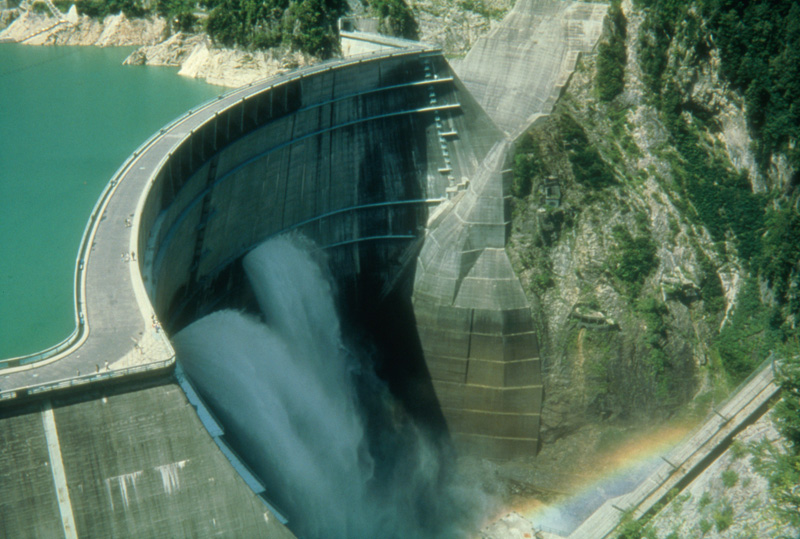
|
Kurobe Dam 黒部ダム is the tallest dam in Japan, standing at a 1,614-feet long and 610-feet high variable radius (dome). The Kurobe Dam is the most popular hydropower site in Japan and between late June and mid-October, water is released from its spillway for onlookers. The Garube 黒部湖遊覧船 is a Kurobe Lake 黒部湖 pleasure boat that allows you to enjoy Kurobe’s glorious nature while gazing up at the looming Northern Alps. The Garube takes 30 minutes to sail around Kurobe Lake, which is located at an altitude of 1,448m. This makes it the pleasure boat operating at the highest altitude in Japan. |
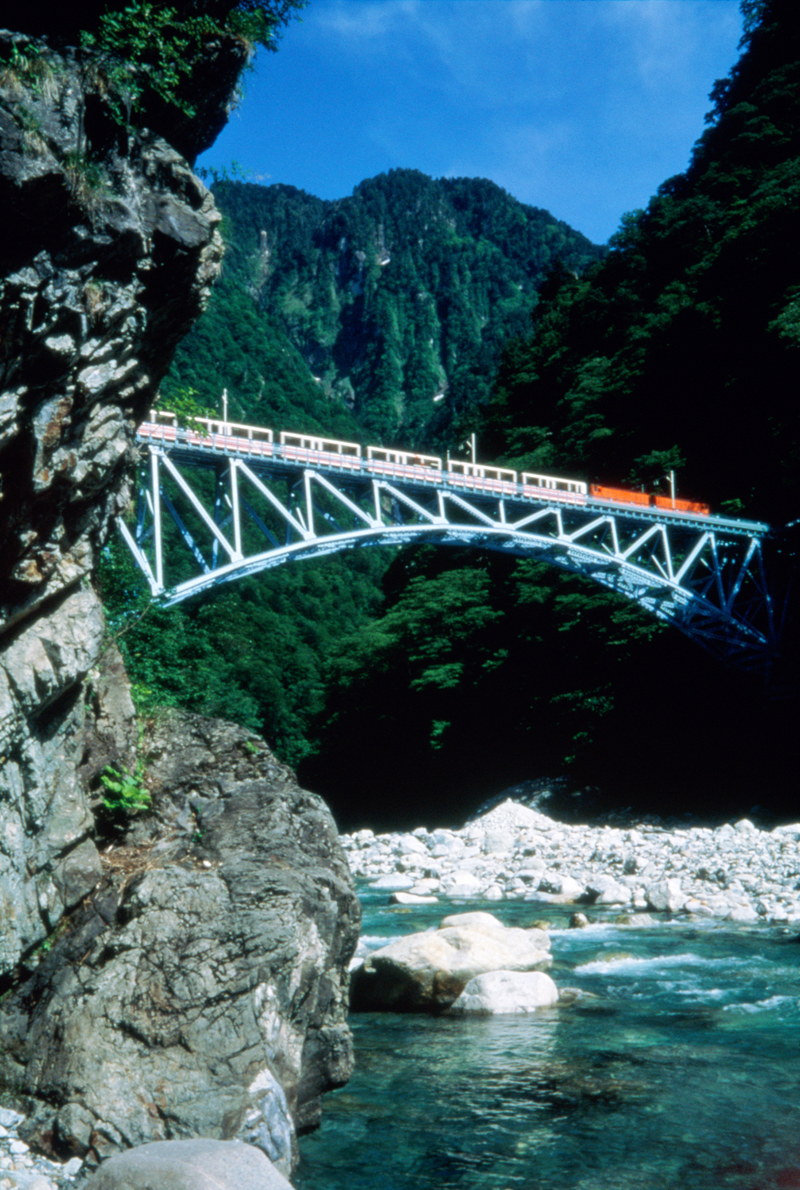
|
The Kurobe Kyoku Tetsudo 黒部峡谷鉄道 (Kurobe Gorge Railway) is considered to have Japan's best views. With the emerald Kurobe-gawa 黒部川 (Kurobe River) winding through it, the Kurobe Kyokoku 黒部峡谷 (Kurobe Gorge) is the deepest V-shaped gorge in Japan. Pure mountain water flowing down its beautiful, rocky slopes lends contrast to the danger of this precipitous, rugged environment. |
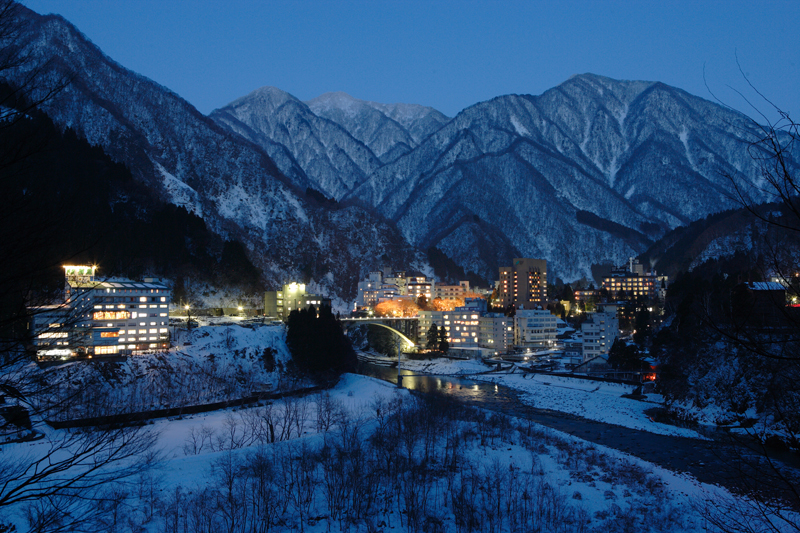
|
Unazuki Onsen 宇奈月温泉 is a beautiful hot spring town that overlooks the splendid nature of Kurobe Gorge. Abundant in hot spring water, it is Toyama's top onsen resort area. Here you can enjoy the scenery and the delicacies of the seasons. Unazuki Onsen is an ideal base for exploring the Kurobe Gorge area.
Enraku 延楽 is one of Unazuki Onsen's historic ryokans 旅館 (Japanese style inns) with private open air onsen bathing. |
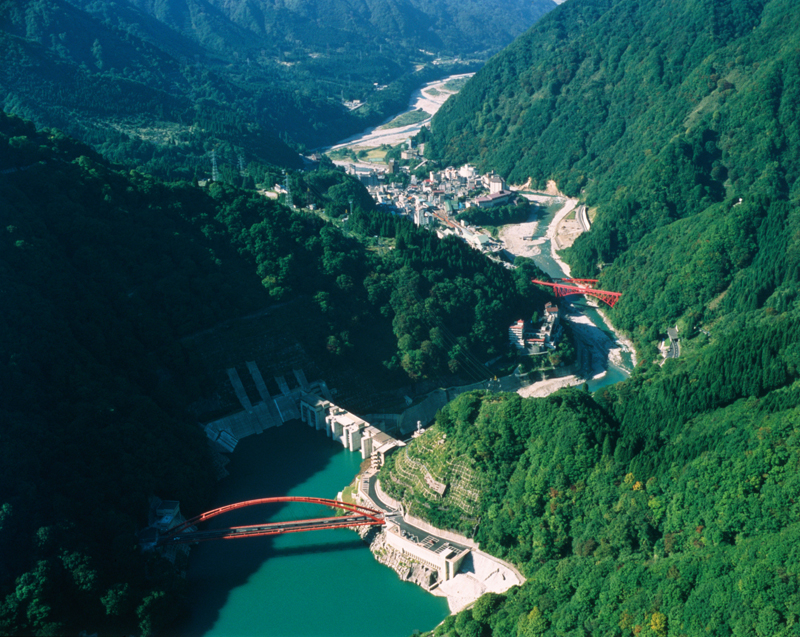
Unazuki Dam 宇奈月ダム
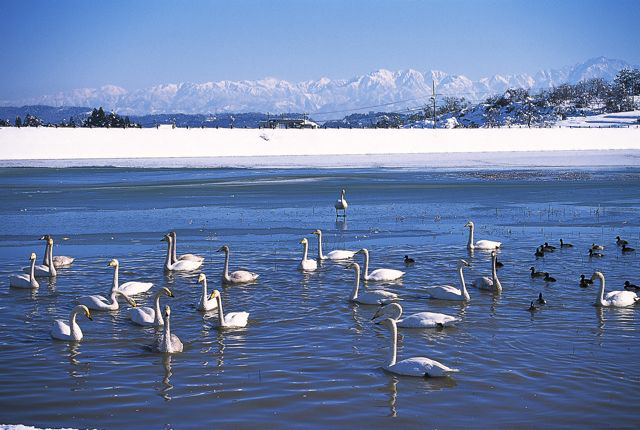
|
Swans migrate in late autumn and spring from Siberia, about 3780km (2350miles) away to Tajiri Pond 田尻池 (Swan Lake) to overwinter in Toyama City. In winter, hundreds of whooper swans and tundra swans fly in flocks. In addition to swans, the area is also home to ducks and other water birds, and has been designated as a wildlife protection area by Toyama Prefecture as the Tajiri Pond Wildlife Protection Area. From November to March, there are also other swan areas in Toyama such as Junimachigata in Himi City, Ishibata Pond in Imizu City, Yamada River in Fuchucho, Toyama City, and around Fuchucho. |
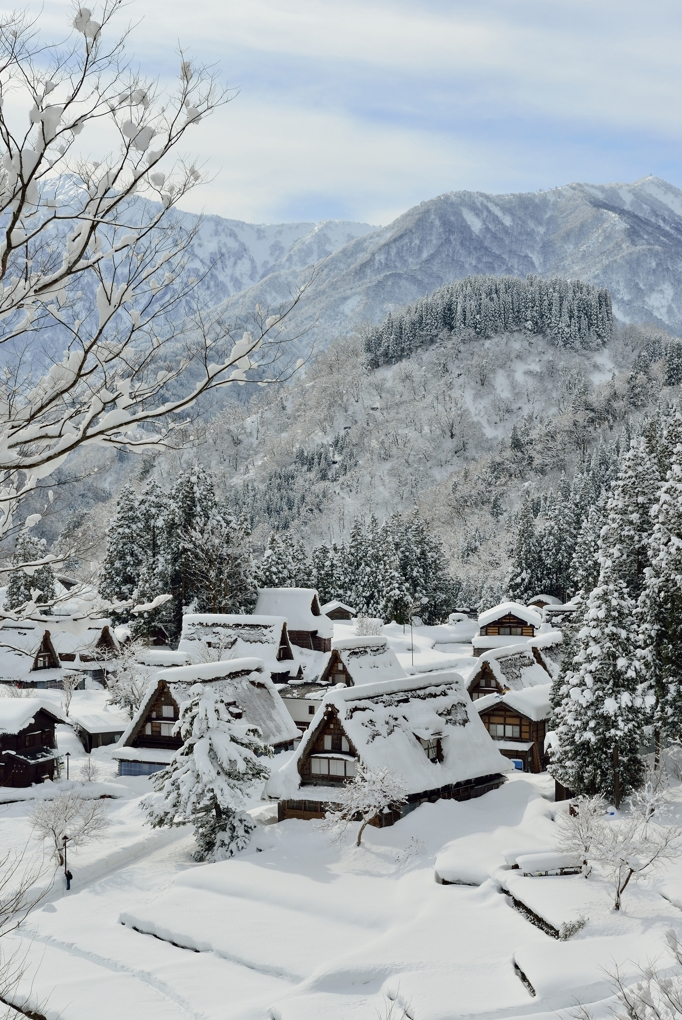
The Historic Villages of Gokayama 五箇山 & Shirakawa-go 白川郷 are UNESCO World Heritage Sites that run across the borders of Toyama and Gifu prefectures, situated along the Shogawa 庄川 river.In the 8th century, the Shirakawa-go & Gokayama area became a location for ascetic religious practices, and mountain worship centered on Mount Hakusan 白山, one of Japan's Three Holy Mountains. Due to its surroundings by steep mountains and heavy snow, its remoteness and difficulty of access severely restricted the connection of this region with the outside world until around the 1950s. This isolation led to the development of its unique culture and traditions, including the architectural tradition of gassho-zukuri 合掌造り (praying hands) farmhouses consisting of steeped 60 degree thatched roofs and built without the use of nails which has been handed down through the generations. For some time this region was known as 'the last unexplored area of Japan'. Gokayama link Shirakawa-go link whc.unesco.org/pg.cfm?cid=31&id_site=734 www.japan.travel/en/japans-local-treasures/shogawa-river-cruise-2022
Tucked away in the forest and embraced by the sacred Hida-Takayama 飛騨高山 mountains, Wanosato 倭乃里, a secluded onsen 温泉 (hotspring) inn with the Miyagawa 宮川 river at its feet is relatively close to Gokayama & Shirakawa-go in Gifu prefecture. Enjoy the cool evenings here with mountain vegetables, broiled river fish, and kapposake warmed over the hearth.
The resort closest to the stars, Hotel Tateyama ホテル立山 is located on top of Mount Tateyama. Visit upon the Yuki-no-Otani snow walls opening from mid-April and spend the night gazing at the stars. Before planning, please check Hotel Tateyama's Events and Seasonal Delights schedules with information such as walking tours, trekking, star gazing, autumn leaves, back country skiing, a visit to Oyama Jinja Shrine, and more. https://h-tateyama.alpen-route.co.jp/en
The new Daiwa Roynet Hotel - Toyama Ekimae is conveniently located across Toyama-Eki 富山駅 train station. The hotel has a helpful concierge and security PIN coded all-in-one washer-dryers including detergent, perfect after a day of trekking. www.daiwaroynet.jp/en/toyama-ekimae
The Hokuriku Shinkansen 北陸新幹線 bullet train extension from Tokyo to Kanazawa & Toyama had opened in March 2015 and to Fukui in March 2024. Temporary visitors (tourist visa) and Japanese nationals living outside of Japan for 10 years can purchase an unlimited Japan Rail Pass for Ordinary (Basic) & Green Class [Premium (f.k.a. First Class)] train cars and can pay an additional charge for GranClass (Luxury) that's only available on new Shinkansen models.
While in Toyama-Eki, pickup a famously local masu-no-sushi ekiben ますのすし 駅弁 (trout sushi train station bento) for your next train ride. It contains slices of cured trout sashimi over Toyama rice tightly wrapped in bamboo leaves and pressed down by the lid. Ekiben are typically eaten cold or at room temperature. With many masu-no-sushi shops in Toyama, each have their own unique flavor. Minamoto Masunosushi Museum has exhibits that show the local history of the dish and explain how it gets its delicious flavor. The museum tour provides a close look at masu-no-sushi being made traditionally by hand. With over a week in advance reservations, visitors may try to make masu-no-sushi under the guidance of an artisan. There is also a factory tour to see part of the ekiben production process, and an exhibition of a collection related to the history of travel and food culture.
The Centram (modern streetcar) loop line route circulates the city center from Toyama station in only 28 minutes with large window views. Conveniently visit the Toyama Glass Art Museum, Toyama Joshi Koen 富山城址公園 (Toyama Castle Park) built in 1543, or just make many inexpensive high quality sushi pit stops all day and night via:
Free Centram and Portram Tickets for international guests: www.toyamashi-kankoukyoukai.jp/en/free-tickets
Minozushi 美乃鮨 is also along the Centram loop line, diagonally across Toyama Castle Park, and nearby the Toyama Glass Art Museum.
Enjoy a short taxi ride into the suburbs of Toyama to dine with our sushi chef friends, Kaoru-san (father) and Takuto-san (son) at Sushi Namba 鮨 難波 (est. 1995).
|
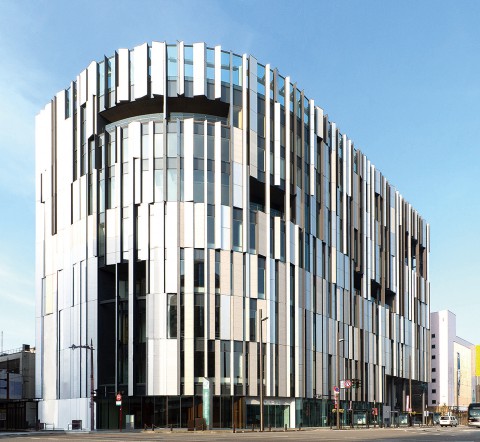
|
Kengo Kuma, a world-renowned architect, designed the Toyama Glass Art Museum. The exterior of the building resembles the ever-changing Tateyama mountain range, and was built with a combination of different materials, such as granite, glass, and aluminum. The interior, on the other hand, makes full use of louvers that use materials from Toyama Prefecture to create an atmosphere of warmth and openness. The Museum holds Permanent Exhibitions, such as the Collection Exhibition displaying the contemporary glass artwork that collected by Toyama City. In the murals of the exhibition rooms and the library, there is the ”Glass Art Passage” that displays artwork from artists associated with Toyama. www.toyama-glass-art-museum.jp
Experience a glass making workshop at the Toyama Glass Studio.
Toyama Institute of Glass Art
Matsukawa River Cruise 松川遊覧船One way to briefly enjoy the seasonal scenery of Toyama City, including its spring cherry blossoms, is to take a hand-rowed boat excursion departing from a platform located in Toyama Castle Park, the symbol of Toyama Prefecture). A cruise on the Matsukawa River, flowing through the center of the city, allows for an exciting tour under the seven bridges that cross over it. With many kinds of wild cherry blossoms and the altitude difference of topography, Toyama can enjoy cherry blossoms for a long term. Starting from the blooming of Kinmame Cherry Tree in middle of March to Takane Cherry Tree in the end of June, Cherry Trees in Toyama keep blooming in each place for approximatey four months and can be seen twice a year in the spring and the fall. |
|
Five Cycling Routes in Toyama video
Tour Guide Interpreters in Toyama |
© 2005-2024 Kamakura, Inc., all rights reserved. ![]()
Privacy Policy & Terms of Use link.